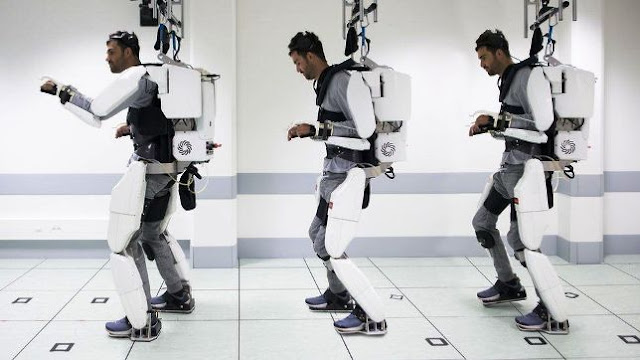
How? With the assistance of a whole-body exoskeleton controlled by a patient's brain waves.
"For the first time, a quadriplegic patient was able to walk and control both arms using this neuro-prosthetic, which records, transmits and decodes brain signals in real-time to control an exoskeleton," said project chief Guillaume Charvet. The experiment was launched by the biomedical research center Clinatec in Grenoble, France.
At the heart of the two-year investigation was a single patient: Thibault, a 30-year-old man from Lyon who does not want his surname used. Four years ago, Thibault lost the ability to move any of his limbs following an accident that caused him to fall more than 40 feet.
But in 2017, two small wireless sensors (each containing 64 electrodes) were implanted on opposite sides of his brain, in an area central to both movement and sensation control.
The sensors would record and wirelessly convey brain signaling to the exoskeleton, which could then turn it into a machine-enabled movement.
To facilitate that process, Thibault spent more than three months working with a high-tech computer simulation program to learn how to control an on-screen representation - much like a video-game avatar - of his appendages.
With his sensor-read thoughts, Thibault eventually learned to manipulate those digital arms and legs, so he could virtually walk and pick up virtual objects.
Those skills were then attempted on the exoskeleton, which looks like a high-tech suit of white armor split in half and fitted to the patient from behind, like a rigid cape.
Outfitted with 14 joints and 14 degrees of freedom, the exoskeleton is designed to enable movement in about 14 unique ways, the researchers noted.
To see how many of those moves he could actually make, Thibault underwent a series of arm and leg movement tests. After 45 sessions in the exoskeleton, the study team deemed the final results a success.
Over six sessions, Thibault was able to walk 73% of the time, although always with the assistance of a ceiling-mounted suspension harness for balance. When tallied with the 33 sessions he spent getting his on-screen avatar to walk, the scientists calculated that Thibault was able to complete 480 steps and move roughly 475 feet.
Thibault was also able to get both hands moving at the same time in an effort to touch targets. He scored a 71% success rate in five execution attempts.
"It was like [being the] first man on the moon," Thibault told BBC News. "I didn't walk for two years. I forgot what it is to stand, I forgot I was taller than a lot of people in the room."
No complications occurred, and the exoskeleton-sensor system only needed to be recalibrated once every seven weeks.
Despite the encouraging findings, Charvet and his colleagues stressed that the exoskeleton is not a cure, and Thibault's status remains the same. They further caution that there is little chance that the investigational technology, as it stands, could be widely deployed anytime soon.
Still, both Thibault and Charvet hope that the research will ultimately lead to technological innovations - such as mind-controlled wheelchairs - that can improve quality of life for immobilized patients. And the investigation continues, with three new patients set to participate.
"This proof-of-concept will open the door to new applications for use of this neuro-prosthetic at home by patients in their everyday lives," said Charvet, whose team reports on its work in the Oct. 3 issue of Lancet Neurology.
But in an accompanying editorial, Tom Shakespeare, a professor of disability research with the London School of Hygiene and Tropical Medicine, said such lofty ambition may need to be tempered by more mundane needs.
"While it is exciting to have developments like this in computer/brain interface, for the vast majority of quadriplegic and paraplegic people, the keys to a better life are good nursing care and good assistive technology," Shakespeare said. "Sip/blow controls and other existing interfaces allow people to operate their chairs, and environmental controls - not the least voice-operated systems - allow people to control their environments.
"The hard work is to make sure all these technologies are available to all the people who might benefit from them," which is, he added, "currently far from the case."
This video supplied by The Lancet Neurology further explains the technology:
Sources: Guillaume Charvet, project chief, Brain Computer Interface, Clinatec, Grenoble, France; Tom Shakespeare, Ph.D., professor, disability research, London School of Hygiene and Tropical Medicine; Oct. 3, 2019, Lancet Neurology; BBC News.







0 Comments